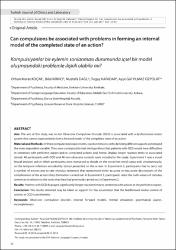| dc.contributor.author | Koçak, Orhan Murat | |
| dc.contributor.author | Kırkıcı, Bilal | |
| dc.contributor.author | Dağlı, Mustafa | |
| dc.contributor.author | Kafadar, Tugay | |
| dc.contributor.author | Özpolata, Ayşe Gül Yılmaz | |
| dc.date.accessioned | 2020-06-25T14:46:15Z | |
| dc.date.available | 2020-06-25T14:46:15Z | |
| dc.date.issued | 2017 | |
| dc.identifier.citation | Koçak, O. M., Kırkıcı, B., Dağlı, M., Kafadar, T., Özpolata, A. G. Y. (2017). Can compulsions be associated with problems in forming an internal model of the completed state of an action?. Turkish Journal of Clinics and Laboratory, 8(2), 35 - 42. | en_US |
| dc.identifier.issn | 2149-8296 | |
| dc.identifier.issn | 2149-8296 | |
| dc.identifier.uri | https://app.trdizin.gov.tr/publication/paper/detail/TWpReU56TTJOZz09 | |
| dc.identifier.uri | https://hdl.handle.net/20.500.12587/1320 | |
| dc.description.abstract | Amaç: Bu çalışmanın amacı, Obsesif Kompulsif Bozukluğun (OKB) bir hareketi tamamlama durumu için oluşturulan ileriye dönük bir modeli, uygun şekilde oluşturamayacağına yönelik bozuk işlevli bir hareket sistemi ile bağlantılı olduğu hipotezin test edilmesidir.Gereç veYöntemler: Çalışmada üç bilgisayar deneyi sunulmaktadır. Her üç deneyde de, farkı durumları ifade eden kelimelere reaksiyon zamanları, ana bağımlı değişkeni oluşturmuştur. Deneyler, OKB'li hastaların mükemmeliyetçilik yönü olan cümlelerde ve/veya tamamlanmış hareketlerde zorluklar yaşadıkları ve bu nedenle bağlantılı bir uyarıya daha uzun reaksiyon zamanları gösterdikleri hipotezini test etmek için yürütüldü. OKB'li toplam 40 katılımcı (Deney 1 de 16, Deney 2 ve 3 de 24'er kişi) ve yaş, cinsiyet, ve eğitimleri uyumlu 40 non-obsesif kontrol katılımcı çalışmaya dahil edildi. Deney 1, katılımcının kelime/kelime dışı bir duruma karar verme konusunda talimat verildiği ve eş zamanlı olarak ekrandaki gösterilen uyarı tarafından kodlanmış temporal referansta, kelimelere ait bir karar verme görevi idi. Deney 2'de katılımcılar bir dizi hareketi yerine getirmek ve kendilerinin yaptıkları hareketlerin bütünlüğünün uygun veya uygunsuz olarak tanımlanıp yansıtıldığı uyarı cümlelerini oranlamak zorunda idi. Deney 3'de katılımcılar, Deney 2'de daha önce yaptıkları görevle bağlantılı olarak, uyarı cümlelerinin doğruluk değerlerini oranladılar.Bulgular: Bulgular bir bütün olarak, OKB'li hastaların kontrol grubu ile karşılaştırıldığında, mükemmeliyetçilik yönü olan hareketlerle ilgili cümlelere daha uzun reaksiyon zamanları gösterdiklerini ortaya koymuştur.Sonuçlar: Elde edilen bulgular, OKB'da ileri beslemeli hareket denetiminin problemli olduğu varsayımını destekleyici olarak ele alınabilir | en_US |
| dc.description.abstract | Aim: The aim of this study was to test Obsessive Compulsive Disorder (OCD) is associated with a dysfunctional motor system that cannot appropriately form a forward model of the completed state of an action.Material and Methods: In three computerized experiments, reaction times to verbs denoting different aspects constituted the main dependent variable. They were conducted to test the hypothesis that patients with OCD would have difficulties in sentences with perfective aspect and/or completed actions and, hence, display longer reaction times to associated stimuli. 40 participants with OCD and 40 non-obsessive controls were included in the study. Experiment 1 was a visual lexical decision task in which participants were instructed to decide on the word/non-word status and, simultaneously, on the temporal reference encoded by stimuli presented on the screen. In Experiment 2, participants had to carry out a number of actions and to rate stimulus sentences that represented either accurate or inaccurate descriptions of the completeness of the actions they themselves carried out. In Experiment 3, participants rated the truth-values of stimulus sentences in relation to the tasks that they had previously carried out in Experiment 2.Results: Patients with OCD displayed significantly longer reaction times to sentences with actions in the perfective aspect.Conclusion: The results obtained may be taken as support for the assumption that the feedforward motor control of actions in OCD is problematic | en_US |
| dc.language.iso | eng | en_US |
| dc.rights | info:eu-repo/semantics/openAccess | en_US |
| dc.subject | Tıbbi Laboratuar Teknolojisi | en_US |
| dc.subject | Tıbbi Araştırmalar Deneysel | en_US |
| dc.title | Can compulsions be associated with problems in forming an internal model of the completed state of an action? | en_US |
| dc.title.alternative | Kompulsiyonlar bir eylemin sonlanması durumunda içsel bir model oluşmasındaki problemle ilişkili olabilir mi? | en_US |
| dc.type | article | en_US |
| dc.contributor.department | Kırıkkale Üniversitesi | en_US |
| dc.identifier.volume | 8 | en_US |
| dc.identifier.issue | 2 | en_US |
| dc.identifier.startpage | 35 | en_US |
| dc.identifier.endpage | 42 | en_US |
| dc.relation.journal | Turkish Journal of Clinics and Laboratory | en_US |
| dc.relation.publicationcategory | Makale - Ulusal Hakemli Dergi - Kurum Öğretim Elemanı | en_US |
















